
Thursday February 22, 2024
Without measures to build long-term resilience, fears are growing that once prosperous herders will end up depending on aid.
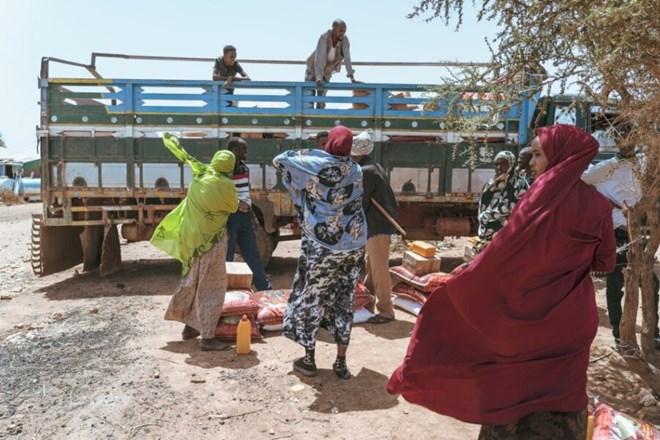
Women affected by years of droughts wait next to a food aid delivery truck in Wado-Baris, Somaliland. Credit: Jaclynn Ashly.
Khader Daheir Muhammad Egal used to be able to support his family comfortably, traversing the land with a large herd of cattle and sheep in search of green pastures. For his whole life, he had enjoyed a nomadic lifestyle that has sustained populations for centuries in the Horn of Africa’s arid environment.
Recently, however, the 40-year-old’s life has dramatically changed. In 2020, recurring droughts that have displaced about 1.4 million people across Somalia, caught up to Egal in Somaliland, the internationally unrecognised nation-state that broke away from Somalia in 1991.
“My animals began dying one by one,” recalls the father of eight children, the eldest of whom is 12 and the youngest of whom was born the previous night.
As life became increasingly difficult, Egal and family travelled across the drought-stricken region to find assistance. They eventually reached the rural village of Wado-Baris near the border with Ethiopia, where relief agencies had set up operations to support people in similar situations. They erected a makeshift home using sticks, old fabric, plastic sheets, and various other leftover materials.Egal and his family are now entirely dependent on aid to survive.
“I took care of animals my entire life,” he tells African Arguments. “We had a lot of animals. We didn’t need charity or outside support to survive. If we were faced with hard times, we would just go sell some of our animals at the market and we’d have enough money for all our needs.”
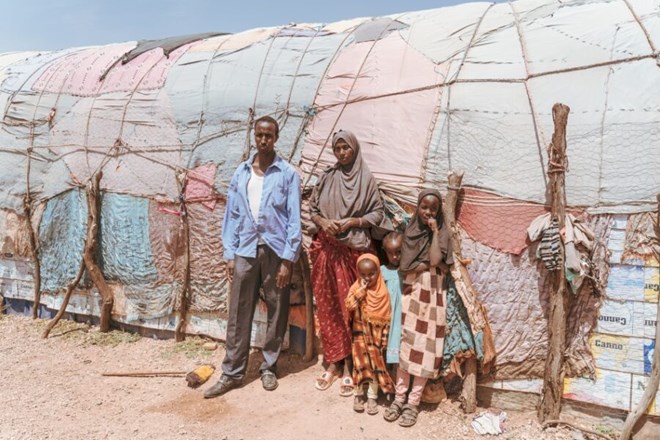
Khader Daheir Muhammad Egal stands with his family outside their makeshift home in Wado-Baris, Somaliland, where they settled after being displaced by the droughts. Credit: Jaclynn Ashly.
“Now we have to ask people for help,” he continues. “If someone doesn’t give us food, then we don’t eat. We used to be rich and now we’re poor.”
Hundreds of thousands of others across the Horn of Africa have shared similar fates of once rich livelihoods being uprooted by severe droughts. Many disperse communities that had been self-sufficient since time immemorial have, in recent years, become lost in the whirlpool of aid dependency.
Factors driving a crisis
In 2022, the Horn of Africa region faced its longest and most severe drought on record following five consecutive below average rainy seasons. The ensuing crisis led to 1.1 million displacements and an estimated 43,000 deaths in Somalia.
Last year, rainfall returned including in the form of heavy rains, linked to the El Nino weather pattern. The resulting flash floods destroyed shelters and uprooted more than a million people in what the UN described as a once-in-a-century event. A looming famine was only narrowly avoided thanks to sustained humanitarian assistance and declining food prices.
The prolonged droughts have devastated crop production and made it near impossible for herders to find food for their animals. About 3.5 million livestock have died from lack of pasture and water, while desperate pastoralists have also sold their livestock to raise money as food and water prices have skyrocketed.
In Somaliland, about 60% of households reported that they had lost all their livestock, according to surveys carried out in 2022 by local non-profit HAVOYOCO. The organisation says that tens of thousands of internally displaced people (IDPs) seek refuge in Somaliland’s capital Hargeisa each year, moving in with relatives or into impermanent settlements on the city’s outskirts.
Somalia is one of the fastest urbanising countries in the world. Abdirahman Edle, a researcher based at the University of Nairobi and University of Copenhagen, attributes this trend to the loss of livelihoods as a result of climate change. “The pastoralist way of life and nomadism has long been the backbone of the Somali economy,” he says. “But it has really suffered in the past two decades.”
Close to 60% of the Somali population are nomadic pastoralists and 80% engage in some kind of livestock-raising. According to the World Food Programme (WFP), a quarter of Somalia’s population is forecast to face “crisis-level hunger or worse” due to drought and floods.
Environmental changes, however, are not the only culprit behind this humanitarian crisis. Ahmed Musa, a senior researcher specialising in aid accountability at the Peace Research Institute Oslo (PRIO), emphasises that a complex combination of political, economic, and social factors have also undermined well-established community coping mechanisms. Armed conflicts, weak state protections, and the historic drawing of colonial borders, which reduced pastoralists’ mobility, have all contributed to the droughts’ severities, he says.
More recently, the Russia-Ukraine war exacerbated the food crisis, with Somalia reliant on these two countries for over 90% of its grain imports. A collapse in demand for livestock in Saudi Arabia has also been a “major factor”, according to Musa. Somaliland usually sees a massive increase in sheep and goat exports ahead of the enormous Hajj pilgrimage, which millions of people typically attend. Its effective cancellation in 2020 and 2021 due to the Covid-19 pandemic made an already critical situation “significantly worse”, he says.
A further source of upheaval was the eruption of conflict last year in the disputed city of Las Anod, which is claimed by both Somaliland and Puntland, an autonomous region of Somalia. The fighting caused hundreds of thousands of people to flee their homes.
A government “taking a back seat”
For many in Somaliland, turning to aid is increasingly becoming the only option. Camps of displaced people are growing year on year.
About 150 families in and around Wado-Baris arrived here after being displaced by droughts, mostly in 2022, according to MSG Foundation, a charity financed and founded by Mohamed Said Guedi, a Somali businessman. The charity has provided health and educational services since 2021. Regular food deliveries and cash transfers are provided through the World Food Programme (WFP).
In the village, a crowd gathers around a truck as it arrives. Men begin offloading bags of donated food items. Others stand in line and press their fingers onto a machine to collect cash transfers. Elsewhere, women slowly make their way back to Wado-Baris from the nearest borehole, at least 30 km away, carrying 20-litre plastic jerry cans of water, some tied to the sides of tired donkeys.
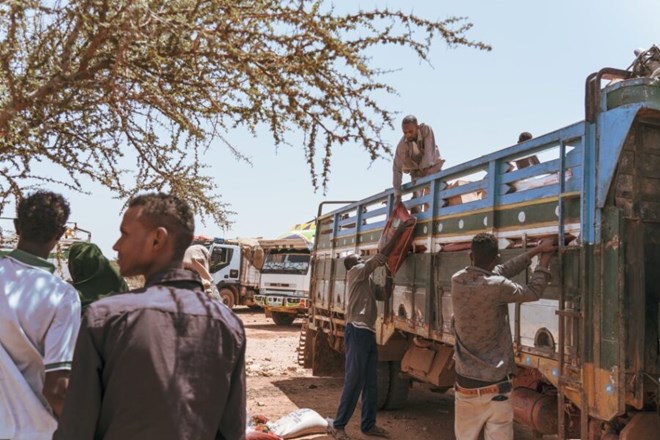
Residents line up for WFP food aid deliveries in Wado-Baris, Somaliland. Credit: Jaclynn Ashly.
One of the women is Egal’s wife, 38-year-old Kulthum Khader. She is returning from an hours-long walk to collect water, despite giving birth the night before. Her children emerge from the home, swarming around her and giggling.
“Since the droughts, everything has gone from up to down,” she tells African Arguments. “My children still suffer from malnutrition because even with the aid sometimes it is not enough. But at least now they are not starving.”
“I fear a lot for the future,” she adds. “We’ve fallen to the very bottom. I don’t know what we will do if things become worse.”
While many local and international NGOs are active in supporting struggling people – providing water, education, and cash transfers in IDP camps – Musa says that the Somaliland state is notably absent. It has failed, he says, to implement social mechanisms to adequately relieve the impacts of climate-related crises or build resilience to help vulnerable populations adapt to shocks.
“The state footprint in the rural areas is very limited,” he explains. “It is mainly Somalis in the diaspora and the international community who provide assistance.”
Musa says that, for more than a decade, the Somaliland government has typically responded to droughts by organising national committees made up of leaders from business and religion, two highly esteemed institutions in Somali society. The government itself “takes a back seat”, leaving the national committees alongside international humanitarian actors and Somali providers to lead the emergency response.
There are few preventative measures. “When the drought has ended, the whole discussion of droughts ends there,” Musa explains. “The government does not allocate a budget for future droughts despite droughts occurring every four years for decades.”
This, Musa says, means authorities are always a step behind when disasters strike, only beginning to act when it is too late. “By the time they are able to raise funds for the drought response, people have already lost their livestock and people have already moved into the IDP camps,” he says.
African Arguments reached out to the Somaliland National Disaster Preparedness and Food Reserve Authority for comment but did not receive a response.
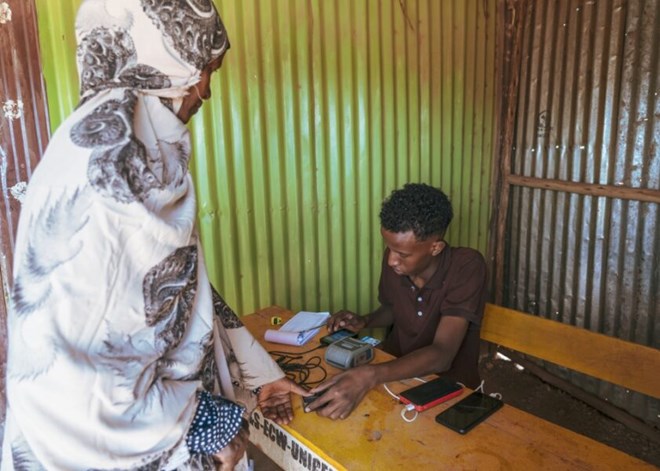
A woman gets her fingerprint read to access her cash transfer in Wado-Baris, Somaliland. Credit: Jaclynn Ashly.
It is the same story throughout Somalia, according to journalist Liban Mahamed, who has worked extensively with drought-stricken populations. He says that it is difficult to know how much of the international aid delivered to Somalia, of which Somaliland would also be a recipient, has actually been spent on people affected by drought.
“For many Somalis, it is hard to believe that billions [of dollars] have been spent on aid,” he says. “The biggest problem is that there’s no new innovation around how best to mitigate drought effects. It’s mostly about immediate relief until the next one strikes.”
“A double-edged sword”
In the absence of preventative measures to build long-term resilience, many observers fear that vulnerable people are falling into, in Mahamed’s words, a “vicious loop of aid dependence”.
Ismail Osman Ali, MSG Foundation’s operation supervisor, also suggests this is a major concern of the charity. This is why, he says, it is planning to create projects to help communities establish farms and lessen their dependence on international aid.
Edle, the researcher, describes aid as a “double-edged sword” and warns that it has become a cause of displacement in of itself by incentivising people to give up on their livelihoods and seek refuge in IDP camps. On the one hand, he says, aid “saves a lot of lives, it can stabilise development, regenerate local businesses, and brings hard currency into the country”. On the other, he adds, “it contributes to underproduction and underdevelopment of the local economy, discouraging people from engaging in businesses that could improve their lives and help the economy”.
Complex questions around aid are not new, especially in Somalia. The long and brutal rule of Mohammed Siad Barre was heavily sustained by international aid, much of which was misused. And “the situation got worse”, according to Edle, when the regime fell in 1991, since when the whole region has relied on foreign aid to build social amenities and boost economic growth.
Among researchers, there is no consensus on whether aid stimulates or constrains the economy, though a recent study by the University of Nairobi concluded that “foreign aid donated to Somalia seems not to translate to positive economic growth”.
In order to prevent people falling into aid dependency, many analysts suggest that aid for climate disasters should include resilience programmes that can help displaced populations become self-sufficient. International organisations have discussed such capacity building schemes as an “exit strategy” from dependence, says Edle, but these approaches “haven’t picked up yet”.
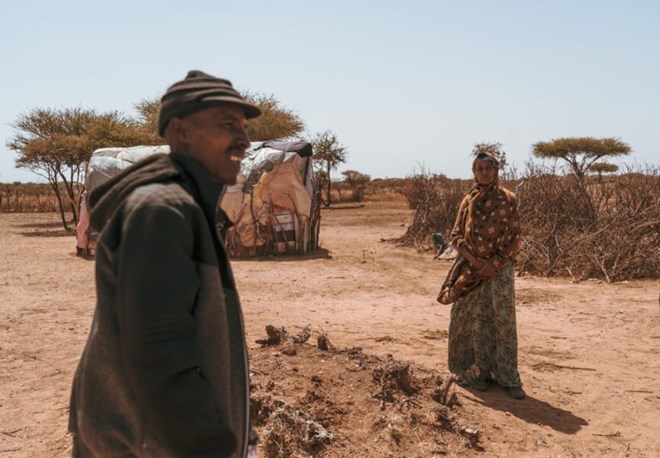
Jamal Haybe stands near his wife outside the family’s makeshift home in Wado-Baris, Somaliland. Credit: Jaclynn Ashly.
Jamal Haybe has no time to think about these issues as he struggles for survival. At least 154 of his camels, cattle, and sheep have died due to starvation or thirst, mostly in 2022. With no other options, he brought his wife and nine children to Wado-Baris to access humanitarian aid.
“Our whole livelihood was selling milk and meat in the towns,” 35-year-old Haybe tells African Arguments, squinting in the harsh sun. “The number of animals I have left is so small…It’s like owning a big farm and then suddenly you are left with just a seed.”
A disease has now spread among the rest of his livestock, numbering around 30. Haybe fears he will soon be left with no livelihood except waiting around for aid trucks.
“If they all die, then I don’t know what will happen to us,” he says. “I try not to think about the future, because it’s too uncertain. Surviving today causes us enough stress. We have put our faith in God and we will keep trying to find ways to survive.”